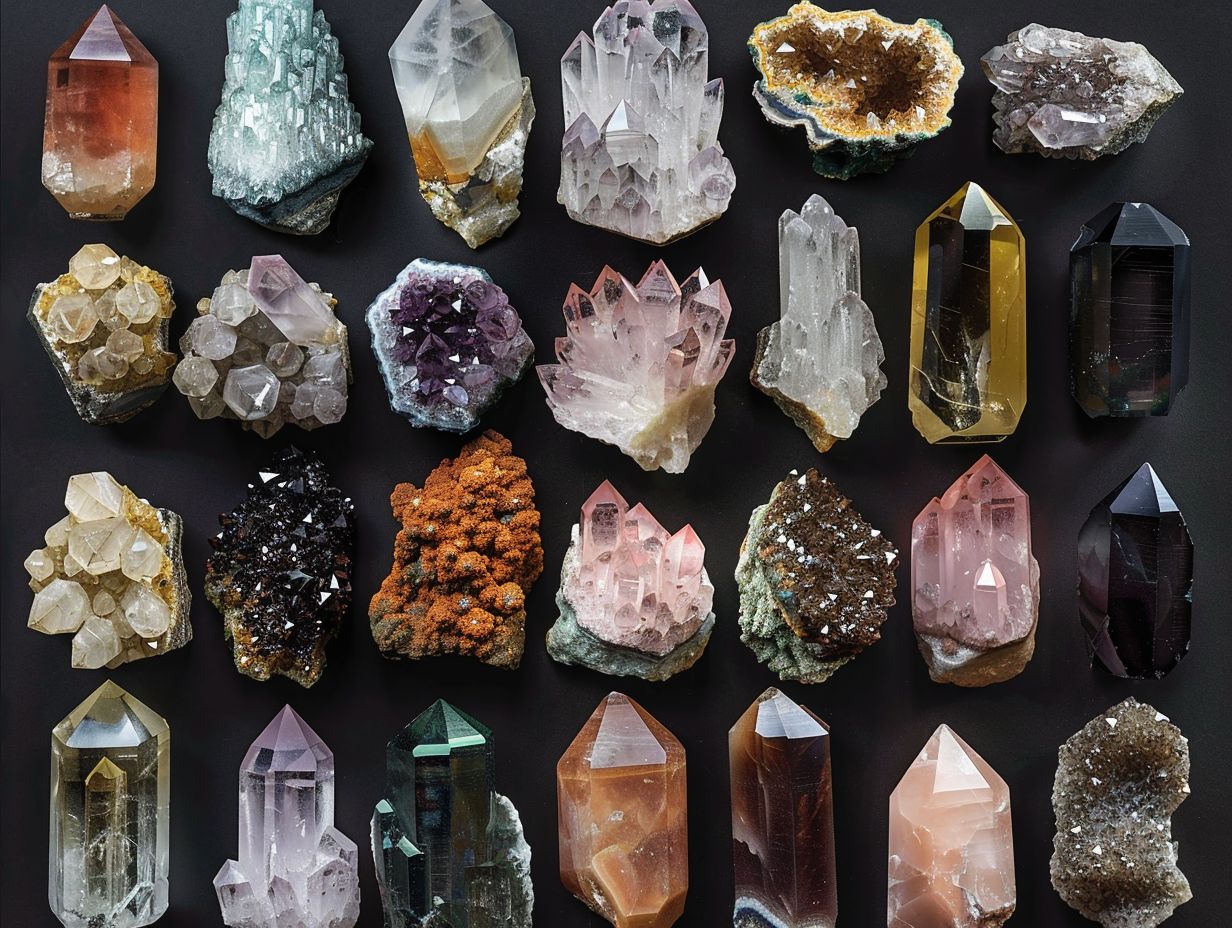
The Art of Crystal Extraction: Techniques and Tools
Have you ever wondered about the process of crystal extraction?
This article explores the art of crystal extraction, including the different techniques and tools used in the process. From water extraction to heat extraction, we delve into the various methods employed to extract crystals effectively.
We discuss the importance of using the right tools and following safety precautions to ensure a successful extraction process. Let’s dive in and uncover the secrets of crystal extraction!
What Is Crystal Extraction?
Crystal extraction involves the process of obtaining crystals from their natural sources, such as mines or quarries, using various extraction techniques and tools for subsequent use in energy work, healing, and spiritual practices.
These extracted crystals play a crucial role in enhancing one’s spiritual journey, as they are believed to possess unique properties that can influence energy fields and promote healing.
The methods used for crystal extraction can vary, ranging from hand tools like chisels and hammers to more advanced technologies in large-scale mining operations. Each crystal holds a distinct energy frequency, making it essential for individuals working with them to select the right crystals aligned with their intentions and goals.
By understanding how to extract and work with crystals effectively, practitioners can harness their healing powers and spiritual vibrations.
Why Is Crystal Extraction Used?
Crystal extraction is utilized to harness the unique energy and healing properties of crystals for spiritual practices, energy work, and promoting holistic well-being and balance.
This process allows individuals to tap into the inherent energy frequencies and vibrations of crystals, facilitating a deeper connection with the earth’s natural elements. By extracting crystals through intentional means, practitioners can enhance their meditation practices, promote emotional healing, and align their chakras to achieve a sense of inner peace and harmony. Harnessing the power of crystals through extraction is a powerful tool for those seeking to elevate their spiritual journey and cultivate a greater sense of balance and well-being in their lives.
What Are The Different Techniques Used In Crystal Extraction?
Crystal extraction employs various techniques such as water extraction, acid extraction, heat extraction, and solvent extraction to separate crystals from their matrix and impurities.
Water extraction involves using water as a solvent to dissolve soluble impurities, leaving behind the desired crystals.
Acid extraction utilizes acidic solutions to dissolve unwanted mineral components and separate them from the crystals.
Heat extraction, on the other hand, utilizes controlled heating to facilitate the separation of crystals from the matrix through differential thermal expansion.
Solvent extraction employs organic solvents to selectively dissolve impurities, allowing the purified crystals to be recovered.
Each of these techniques plays a crucial role in the purification and isolation of crystals for various applications.
Water Extraction
Water extraction is a common technique used in crystal extraction processes, where crystals are separated from their host materials by immersing them in water to dissolve surrounding impurities.
This method is particularly effective for separating crystals that are closely embedded within their matrix. As the impurities dissolve in the water, the crystals start to break away and can be easily collected for further processing. The water acts as a medium to carry away the impurities, leaving behind the purified crystals. Once the crystals are fully separated, they can be dried and stored for various uses, such as in jewelry making, manufacturing, or even healing practices.
Acid Extraction
Acid extraction is a method employed in crystal extraction, involving the use of acidic solutions to dissolve unwanted substances and separate the crystals for subsequent purification.
This technique plays a crucial role in the purification process by dissolving impurities that may have attached themselves to the crystals during their formation. The acidic solution breaks down these impurities, allowing the pure crystals to be easily isolated and collected. Acid extraction is particularly effective in cases where other methods such as filtration or recrystallization may not be suitable for removing specific impurities. By utilizing acidic solutions, researchers and scientists can achieve high levels of purity in their crystal samples for various analytical and research purposes.
Heat Extraction
Heat extraction is a technique used in crystal extraction processes, where controlled heating is applied to crystals to separate them from their surrounding matrix or impurities.
This method is crucial in extracting pure crystals for various industries such as pharmaceuticals, electronics, and jewelry making. By subjecting the crystals to specific temperatures, the heat causes the matrix or impurities to break down, allowing the crystals to be easily separated. The significance of this process lies in its ability to produce high-quality and well-defined crystals, which are essential for research purposes and commercial applications. Heat extraction plays a vital role in ensuring the purity and efficiency of crystal extraction methods.
Solvent Extraction
Solvent extraction is a technique in crystal extraction that involves the use of solvents to dissolve impurities and extract crystals from their natural matrices for purification.
This method is commonly used in industries such as pharmaceuticals, mining, and food processing to isolate pure substances from complex mixtures.
By selectively using solvents with specific chemical properties, it is possible to target particular impurities while leaving the desired crystals untouched.
Solvent extraction is preferred for its efficiency and scalability, making it suitable for both small-scale operations and large industrial applications. This technique plays a crucial role in ensuring the quality and purity of the final product.
What Tools Are Needed For Crystal Extraction?
- Crystal extraction requires specific tools such as mortar and pestle, filter paper, funnel, beakers, flasks, hot plates, and glass stirring rods to facilitate the extraction and purification processes effectively.
The mortar and pestle are used to crush and grind larger crystal specimens into smaller particles, helping to increase the surface area and enhance extraction efficiency.
Filter paper aids in separating solid impurities from the crystal solution. The funnel assists in transferring liquids between containers and isolating crystals during the filtration process. Beakers and flasks provide containers for mixing, heating, and storing crystal solutions at different stages.
Hot plates are crucial for maintaining consistent temperature levels during crystallization, while glass stirring rods aid in stirring and promoting crystal growth in the solution.
Mortar and Pestle
A mortar and pestle are indispensable tools in crystal extraction, used for grinding and crushing crystals into desired sizes for further processing and purification.
These traditional utensils have been utilized for centuries across various cultures for their effectiveness in breaking down crystals into fine powders. The grinding action of the mortar and pestle helps release the energies and properties trapped within the crystals, making them more accessible for purification rituals or creating elixirs.
By gently crushing the crystals, practitioners can enhance the potency and purity of the final product, ensuring a harmonious energy resonance for spiritual practices and healing purposes.
Filter Paper
Filter paper is a crucial tool in crystal extraction processes for separating crystals from liquid solutions and impurities, ensuring the purity of the extracted crystals.
This specialized paper acts as a physical barrier that traps the solid crystals while allowing the liquid and impurities to pass through. The filter paper’s porous nature facilitates the filtration process by providing a medium for the separation to occur efficiently. By effectively removing unwanted substances, the filter paper helps to isolate the valuable crystals, maintaining their quality and purity. Without the use of filter paper, the extraction process would be less precise and the resulting crystals could be contaminated with impurities.
Funnel
A funnel is an essential tool in crystal extraction, facilitating the transfer of liquids and solutions containing crystals or impurities for separation and purification.
This crucial apparatus plays a pivotal role in the process by channeling the solutions laden with target crystals through its narrow stem, allowing for precise pouring and layer separation. By strategically pouring the solution into the funnel, the heavier crystal-laden liquid settles at the bottom, while lighter impurities float on top, enabling a controlled purification process. The shape of the funnel ensures a smooth and efficient transfer, directing the liquid with minimal loss of valuable crystals, thus optimizing the yield of the extraction process.
Beakers and Flasks
Beakers and flasks are utilized in crystal extraction to hold and contain liquid solutions, crystals, or impurities during various stages of the extraction and purification processes.
The beakers primarily serve the function of mixing and heating the solutions, facilitating the dissolution of crystals and impurities. On the other hand, flasks play a crucial role in the crystallization process by providing a controlled environment for the formation of pure crystals. Beakers aid in the separation of the liquid phase from solid crystals and impurities through techniques such as filtration and decantation, while flasks are essential for the recrystallization of purified compounds. Together, these glassware pieces are indispensable tools in the intricate process of crystal extraction and purification.
Hot Plate
A hot plate is a valuable tool in crystal extraction, providing controlled heat for processes that require heating of solutions or crystals for separation and purification.
By utilizing a hot plate, researchers are able to carefully regulate the temperature of the solution or crystal, ensuring an efficient extraction process without causing damage. In specific extraction methods such as recrystallization, the hot plate plays a critical role in dissolving impurities or unwanted substances, allowing the pure crystal to form through controlled cooling. The ability to adjust the heat settings of the hot plate provides flexibility for different types of crystals, making it an indispensable instrument in the field of crystallography.
Glass Stirring Rod
A glass stirring rod is a necessary tool in crystal extraction for mixing and stirring solutions containing crystals or impurities, ensuring uniformity and efficiency in extraction processes.
It plays a crucial role in the extraction and purification procedures by allowing the user to thoroughly mix the solution for an even distribution of crystals. The gentle stirring action of the glass stirring rod prevents damage to delicate crystals while aiding in the separation of impurities. This tool also helps in controlling the temperature of the solution, contributing to the overall success of the crystal extraction process. Its versatility and durability make it an indispensable instrument in the realm of crystallography.
What Are The Safety Precautions For Crystal Extraction?
Safety precautions are crucial in crystal extraction to ensure a safe working environment, including the use of protective gear, working in well-ventilated areas, and following proper handling and disposal procedures for hazardous materials.
Protective gear such as goggles, gloves, and masks should be worn to shield against potential eye injuries, skin irritation, and inhalation of harmful dust particles during the crystal extraction process. It is vital to work in a well-ventilated space to minimize exposure to any fumes or airborne particles generated during extraction.
Strict adherence to protocols for handling and disposing of materials is imperative to prevent environmental contamination and personal harm. By prioritizing safety measures, practitioners can continue to enjoy the benefits of crystal extraction without compromising their health and surroundings.
Use Protective Gear
Utilizing protective gear is essential in crystal extraction to safeguard against potential hazards and ensure personal safety during the handling and processing of crystals and chemicals.
These protective measures play a crucial role in minimizing risks such as exposure to harmful chemicals, cuts, and eye injuries. Respiratory masks are vital for filtering out airborne particles, while gloves shield against chemical burns and cuts. Safety goggles provide eye protection from splashes and debris, and sturdy footwear prevents slips and falls. By wearing the appropriate gear, individuals can work confidently in the extraction process, knowing that they are shielded from various dangers that come with handling crystals.
Work in a Well-Ventilated Area
Working in a well-ventilated area is imperative during crystal extraction to minimize exposure to fumes, dust, and potentially harmful substances, promoting a safe and healthy workspace.
Proper ventilation plays a crucial role in maintaining air quality and safeguarding the well-being of individuals involved in the extraction process. By ensuring that harmful vapors and particles are promptly removed, ventilation systems create a healthier environment where the risk of respiratory issues and other health hazards is significantly reduced. This not only benefits the physical health of those working with crystals but also contributes to a more efficient and comfortable working atmosphere, allowing for better focus and productivity.
Follow Proper Handling and Disposal Procedures
Adhering to proper handling and disposal procedures is critical in crystal extraction to mitigate environmental impact, prevent contamination, and ensure the safe management of hazardous materials and waste.
Proper management of materials and waste is key to safeguarding ecosystems and human health. By following correct protocols, operators can minimize the release of toxic substances into the environment.
This involves using specialized equipment to handle materials safely and implementing containment measures to prevent spills and leaks. Proper disposal techniques, such as recycling and treating waste before disposal, play a crucial role in reducing the overall environmental footprint of crystal extraction operations.
What Are The Common Mistakes In Crystal Extraction?
Several common mistakes can occur during crystal extraction, such as using the wrong technique, working with contaminated tools, and neglecting proper safety precautions, leading to compromised results and potential hazards.
An incorrect technique may include applying too much force when extracting crystals, which can result in breakage and loss of valuable specimens.
Tool contamination, often overlooked, can introduce impurities into the crystals, affecting their purity and clarity.
Safety lapses, like improper ventilation or inadequate protective gear, can put individuals at risk of exposure to harmful chemicals or shards of broken crystals.
These errors not only impact the quality of the extracted crystals but also pose serious safety concerns for those involved in the extraction process.
Using the Wrong Technique
One prevalent mistake in crystal extraction is employing the wrong technique, which can result in ineffective separation, damage to crystals, or incomplete purification processes, affecting the quality of extracted crystals.
Utilizing inappropriate methods during crystal extraction may lead to various negative outcomes. Incorrect techniques could cause crystals to break or fracture, diminishing their overall quality and value. If the separation process is not conducted accurately, impurities may remain attached to the crystals, impacting their purity. This, in turn, can hinder the effectiveness of subsequent purification steps, resulting in incomplete purification and reducing the overall yield of high-quality crystals. Therefore, it is crucial to employ proper extraction techniques to ensure optimal crystal quality, separation efficacy, and purification success.
Using Contaminated Tools
Another common error in crystal extraction is working with contaminated tools, which can introduce impurities into the extraction process, compromising the purity and quality of the extracted crystals.
These impurities from the tools not only affect the appearance of the crystals but can also alter their chemical composition. Contaminants can lead to inconsistencies in crystalline structure and compromise the overall integrity of the final product, making it less valuable in applications requiring high purity.
To avoid these detrimental effects, it is crucial to regularly clean and sterilize tools used in crystal extraction processes. By maintaining clean tools, crystal growers can ensure the production of high-quality, pure crystals for various industries and research purposes.
Not Following Proper Safety Precautions
Neglecting proper safety precautions during crystal extraction poses significant risks to personal well-being and environmental safety, potentially leading to accidents, injuries, or exposure to hazardous materials.
Disregarding safety measures in crystal extraction not only jeopardizes the physical health of individuals involved but also has long-term consequences for the surrounding environment. Accidents resulting from negligence can cause severe injuries, lasting trauma, and even fatalities. Improper handling of hazardous materials during extraction can lead to environmental contamination, poisoning wildlife, contaminating water sources, and disrupting the ecological balance of the area. It is crucial for all individuals engaged in crystal extraction to adhere to strict safety protocols to avoid such detrimental outcomes and uphold the well-being of both people and nature.
How To Increase Crystal Extraction Yield?
Enhancing crystal extraction yield involves using high-quality crystals, employing the correct extraction technique, and utilizing the right tools and equipment to maximize the efficiency and effectiveness of the extraction process.
Quality crystals are essential as they contribute significantly to the purity and yield of the final product. Opting for top-grade crystals ensures a higher success rate in the extraction process, leading to superior outcomes.
By mastering the appropriate extraction techniques, one can minimize wastage and enhance the overall yield. Employing suitable tools such as precision tweezers, filtration systems, and quality containers facilitates a smoother extraction process, allowing for increased efficiency and productivity.
Use High-Quality Crystals
Utilizing high-quality crystals in extraction processes is essential for improving yield and enhancing the purity and vibrational properties of the extracted crystals, ensuring optimal outcomes.
The superior quality of crystals plays a crucial role in maximizing the extraction yield by providing a more efficient and effective extraction process. When high-quality crystals are used, they contribute to a higher level of purity in the final product, which is vital for various applications in industries like pharmaceuticals, cosmetics, and spirituality.
Superior crystals bring a level of consistency and reliability to the extraction process, ensuring that the resulting extracts are of top-notch quality and potency. This emphasis on quality not only elevates the end product but also enhances the overall customer experience and satisfaction.
Use the Correct Extraction Technique
Employing the appropriate extraction technique is crucial for increasing crystal yield, as each method has specific benefits and efficiency levels, influencing the quantity and quality of extracted crystals.
The selection of the extraction method not only affects the amount of crystals obtained but also plays a vital role in the overall purity and consistency of the final product. By choosing the right technique, one can optimize the extraction process to maximize the yield and improve the quality of crystals produced. Factors such as solvent choice, temperature control, and extraction time significantly impact the outcomes. For instance, employing a solvent that selectively dissolves the desired components can enhance the efficiency and ensure a higher purity of the extracted crystals.
Use the Right Tools and Equipment
Utilizing the correct tools and equipment in crystal extraction processes enhances efficiency, precision, and safety, contributing to higher extraction yields and improved quality of the extracted crystals.
The role of suitable tools cannot be overstated in achieving optimal extraction outcomes. From high-quality tweezers for delicate handling to advanced filtration systems for separating impurities, each tool plays a crucial part in the process.
The use of precise measurement instruments ensures accurate ingredient proportions, while safety equipment like goggles and gloves protect workers from harmful substances. By integrating these tools seamlessly into the extraction workflow, operators can streamline their operations, reduce the risk of accidents, and consistently produce top-quality crystals.




No Comments